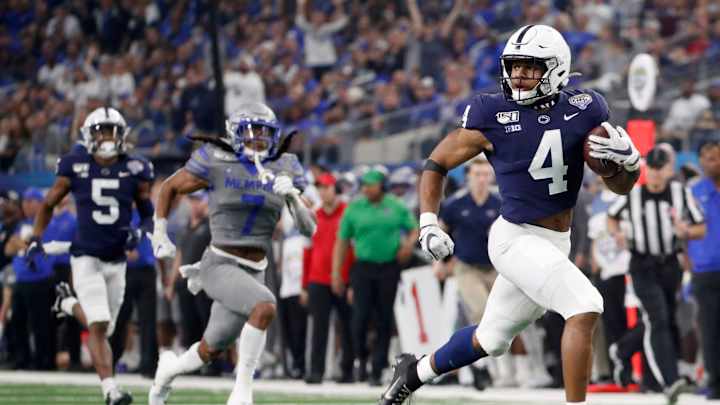What's Next for Journey Brown?

Quarantine felt almost familiar to Penn State running back Journey Brown. Last summer, Brown trained at home while serving a team suspension, anxious the whole time that his fellow backs were getting ahead of him.
So even after his star turn at the Cotton Bowl, where he became the first Penn State player to rush for more than 200 yards in a bowl game, Brown approached his home training schedule with the same humble fire. He thought about his late grandmother, about the family and friends who pushed him to be better on the field and about the next skill he wanted to master.
About the only difference was, this past spring, Brown had to leave the Meadville High football field, which was closed because of the novel coronavirus, while running extra drills. Otherwise, Brown trained on his own again, determined not to get left behind.
“I never thought I would be in this position again, but everything happens for a reason,” Brown said. “… Eventually, stuff like this is going to come to an end, and I don’t want to be behind when it’s over. Same as last summer. I was afraid that everybody was getting ahead of me and everybody was going to beat me out. So I’m applying that to now.”
Entering his fourth year at Penn State, Brown is among the offense’s most intriguing players. He rode a remarkable incline last season, from rejoining the team prior to training camp to his breakthrough performance against in the Cotton Bowl.
Brown rushed for a Penn State bowl-record 202 yards and two touchdowns against Memphis, capping a five-game stretch in which he averaged 118.6 yards per outing.
Running backs coach Ja’Juan Seider said he thought Brown was among the best backs in the country over that stretch. Seider was particularly impressed with the way Brown played in games against Minnesota and Ohio State.
“He has freakish athletic ability and strength that he’s finally starting tap into,” Seider said. “And I think the thing I was so impressed with in the bowl game was finally getting him to play as fast as he is.”
Brown famously arrived at Penn State after winning the 100-meter dash at the Pennsylvania state track championships in a state-record 10.43 seconds. But he said he received few college offers to run track, largely because he told interested coaches that he wanted to play football.
But, as Seider said, Brown began trusting more than his speed on the field last season.
“Coming from a small town, I probably didn’t have most of the skills of the 5-star guys coming in or the exposure or the training they had, so I relied on my speed a lot,” Brown said. “Most of my film was just me outrunning people, but I always knew I was a running back. … At the end of my sophomore year is when I felt like I really started getting it and it started clicking and I really started feeling comfortable. I started turning into that Swiss-Army knife type of guy instead of being just a one-trick pony.”
Brown spent spring break at a training center in southern California, where he worked out with former teammate Juwan Johnson and other NFL-bound players. He ended up staying in California for the remainder of the month after Penn State closed its campus and travel complexities arose.
In California, Brown drilled pass-catching, one aspect of his game that he wanted to improve. He expected that to be a focus of spring drills. Instead, he brought those drills home.
This spring Brown worked at a local car dealership, cleaning and preparing used vehicles for resale. After that, he caught passes from a high-school friend who plays quarterback. Brown increased the drill difficulty by wearing bands on his hands that restricted their movement, forcing him to catch with his fingers.
“I feel like that was the weak part of my game,” said Brown, who caught 13 passes last season. “I want to take that to the next level.”
Brown, who turned 21 while in California, acknowledged two qualities to which Seider attributed his growth: maturity and confidence. During the second half of last season, Seider said, Brown was playing as well as Miles Sanders had the year before.
The “light bulb went on,” Seider said, and now Brown is “doing stuff that is amazing to see.”
“The way he was making safeties miss and erasing the defense, that’s impressive,” Seider said. “You don’t wake up with that gift every day. He’s tapping into it, and I don’t think he’s satisfied. I think he’s hungry, because he got a taste of it and he realized how good he can be.”
During the 2018 season, Brown’s grandmother, Helen Leona McCracken, passed away. It was one of several personal tragedies that Brown has faced the past few years, prompting head coach James Franklin to say that he hasn’t coached a player who has overcome more adversity.
To this day, Brown begins workouts thinking of her.
“My motivation has always been my grandma, of course,” he said. “When she was here, she wasn’t able to get up and be mobile. I’m 21 years old, I’m able to be mobile. If she could have what I have, she would never stop moving. So, I can’t let my family down.”

Mark Wogenrich is the editor and publisher of Penn State on SI, the site for Nittany Lions sports on the Sports Illustrated network. He has covered Penn State sports for more than two decades across three coaching staffs, three Rose Bowls and one College Football Playoff appearance.